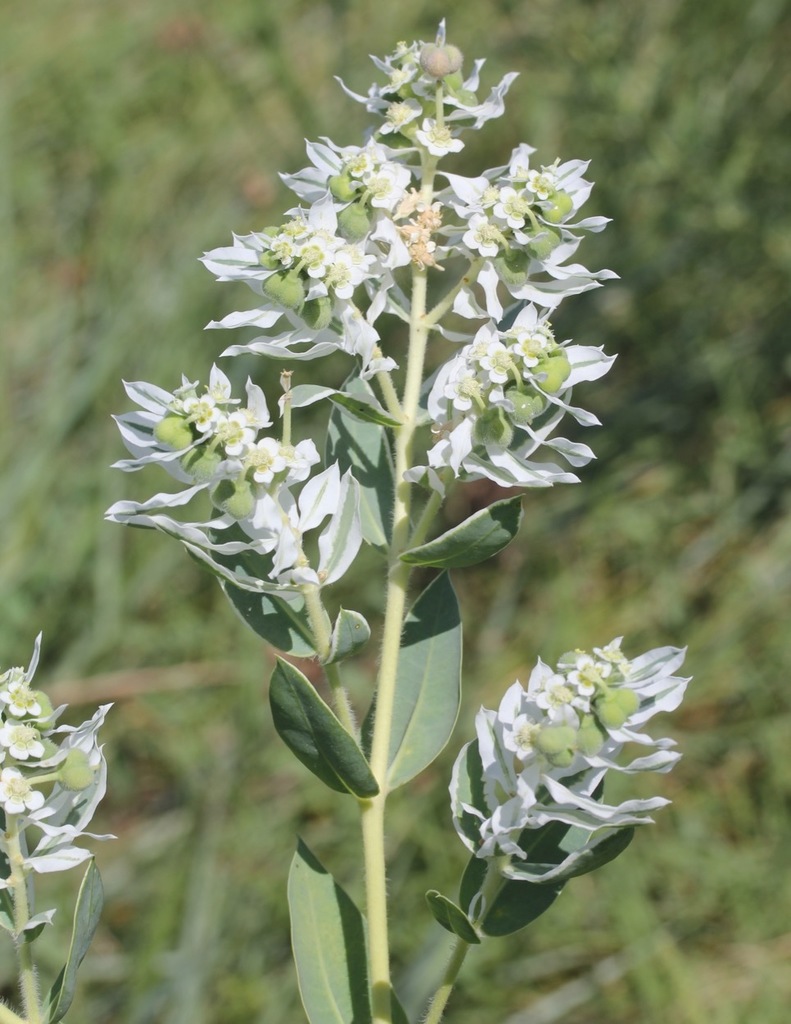Euphorbia marginata (Snow-on-the-Mountain) and E. bicolor (Snow-on-the-Prairie)
I recently went through E. marginata and E. bicolor and found some characters that might help those trying to distinguish between the two snowy plants.
Euphorbia marginata:
Upper sides of most or all leaves glabrous (occasionally hairy on lower leaves, especially along the midvein). Bracts broad, largest ones typically elliptic with the broadest point near the middle. Smaller bracts becoming oblong or even oblanceolate with the broadest point at the apex, as long or typically shorter than the rest of the leaves.
The bracts are typically the same length as or shorter than the rest of the leaves, but can occasionally get to 1.5 or maybe even 2 times the length on occasions. These extra long leaves are quite broad and closely resemble the actual leaves in shape and size despite the white margins.

Image source: Nathan Taylor
More examples:
Young growth (no inflorescence)
Young inflorescence 1
Young inflorescence 2
Inflorescence with narrow bracts
Euphorbia bicolor:
Upper sides of leaves hairy (and often densely so). Bracts long and narrow, largest ones typically linear or narrowly oblanceolate with the broadest point at or near the apex. Smaller bracts linear or if approaching oblanceolate, then longer than the regular leaves.
The bracts that seem to be in transition from the leaves are often oblong but are typically shorter than the more apical linear to narrowly oblanceolate bracts.

Image source: Lisa Winnett-Pequeno
More examples:
Young growth (no inflorescence)
Young inflorescence
Rare pink form
This is adapted slightly from Flora of North America, but their treatment says that the leaves of E. marginata are glabrous in the key when in actuality they can be densely hairy, though not on the upper surface and typically most restricted to the midvein. I hope this helps.
If you're interested in the geography differences between these two species, I have a map of all the observations I've IDed here. Note that the map only includes the US (the region of overlap between the two species) and is based on an experimental tool that may be removed.





תגובות
Extremely useful -- thanks for putting this together, Nathan. I've incorrectly ID'ed far too many of these. :-/
They're pretty tricky. Especially on the E. marginata plants that have narrowly oblong leaves. I'm actually a bit surprised how quickly I picked this up. I normally pick a few characters that turn out to be variable, then have to revise my concept multiple times before I'm satisfied that I've got the right ideas down. If there's one thing I enjoy though, it is a consistent hair/lack of hair character. That is something I can work with any day of the week.
I wonder if any of the 70 or so photos of these two species on the Lady Bird Johnson Wildflower Center's website are misclassified.
I frequently encounter misidentified photos at their website, so it wouldn't surprise me.
On a peripheral note, does anyone know how the Establishment Means for E. marginata got set to Introduced for the Edwards Plateau? I don't know if that is correct or not, but actually trying to figure out how or where iNat got that info is like running into a brick wall. @sambiology @nathantaylor7583
I'm not sure. I think I'll change it to unknown for now at least. I don't know enough about the occurrence of the species on the Edwards Plateau to know. @gcwarbler might be able to provide some insight as well.
So is that info simply set by a curator? It seems like there should be some way on iNat to figure out who sets that info or where it came from, but perhaps that is more of general iNat issue.
It seems that the TPWD Wildlife District 4 covers the same area and is also marked as Introduced. Haha. It looked like it would let me change that field, but honestly I am not sure the average user should be able to change that field without some sort of tracking.
Probably not. I wonder why TPWD lists it as introduced? I'm really hoping someone more acquainted with the region will be able to give some insight here. It doesn't really make much sense to me. BONAP has it as native, though, I don't know if it checks introduced status to county level (http://bonap.net/MapGallery/County/Euphorbia%20marginata.png).
This is just a clerical error, perhaps on the part of TPWD. E. marginata is undoubtedly native on the plateau. I rather suspect that the species is introduced (e.g. Bastrop County) to the E of I-35, but, with the exception of the eastern parts of the counties along that highway, that's not in TPWD District 4.
I've tried to change some of the native status of a few species on iNat with no success. :-/
I suspected as much but wanted to get the opinion of someone familiar with the area. Thanks! I think I'll change it to native now.
Sam, you have to go to the checklists of the page of the location that you want to change the status of. From there you can click "edit", which should allow you to change the status. Or at least, that's what I did. I guess it's possible that some lists won't allow edits.
For the record, I changed District 4 to native.
Update: I added a couple photos.
Update: If you're interested in the geography differences between these two species, I have a map of all the observations I've IDed here. Note that the map only includes observations from the US (the region of overlap between the two species) and is based on an experimental tool that may be removed.
Cool tool! I wanna play with it!
הוספת תגובה